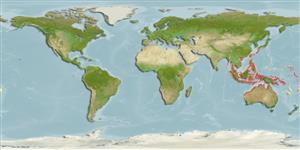Common names from other countries
Environment: milieu / climate zone / depth range / distribution range
Ecología
. Tropical
Indo-West Pacific.
Length at first maturity / Tamaño / Peso / Age
Maturity: Lm ? range ? - ? cm Max length : 6.0 cm ShH macho / no sexado; (Ref. 349); common length : 5.0 cm SHL macho / no sexado; (Ref. 349)
Shell medium sized, solid, elongateovate in outline, not shouldered. Spire apex blunt, often corroded in mature specimens. Sculpture of numerous axial grooves and fine spiral lines, causing a finely latticed pattern throughout the surface of shell, though it is somewhat stronger on posterior half of body whorl than on anterior half. Periostracum tough, closely applied to shell. Outer lip of the aperture thick and smooth inside, with a low swelling at about the middle. Inner lip glazed, with 3 folds; posterior fold tooth-like, centre fold oblique, large and angular, anterior fold weak and almost axial in direction. Colour: outside of shell whitish under the dark brown periostracum. Aperture porcelaneous white.
Found at mangrove swamps, Nipa palm forests and mud flats near the coast (Ref. 349). An epifaunal deposit feeder (Ref. 129221).
Life cycle and mating behavior
Madurez | Reproducción | Puesta | Huevos | Fecundidad | Larva
Members of the order Pulmonata are mostly simultaneous hermaphrodites.
Poutiers, J.M. 1998. (Ref. 349)
IUCN Red List Status (Ref. 130435)
CITES status (Ref. 108899)
Not Evaluated
Not Evaluated
Human uses
Pesquerías: pesquerías de subsistencia
| FishSource |
Herramientas
Fuentes de Internet
Estimates based on models
Preferred temperature
(Ref.
115969): 24.7 - 29.3, mean 28.7 (based on 1905 cells).
Vulnerability
Moderate to high vulnerability (50 of 100).
Price category
Unknown.
